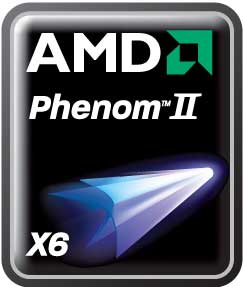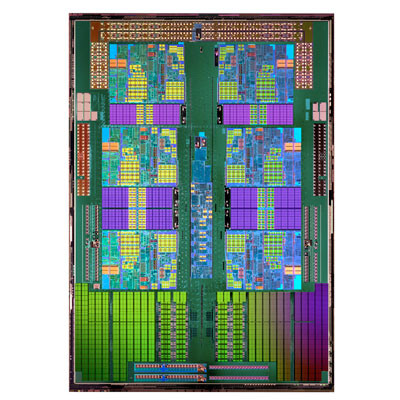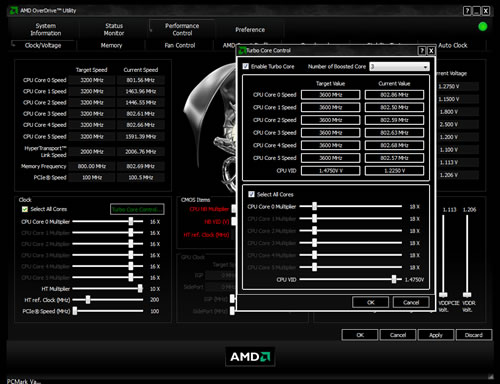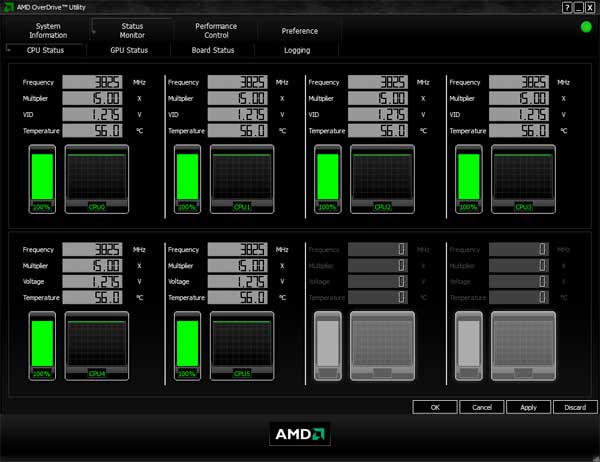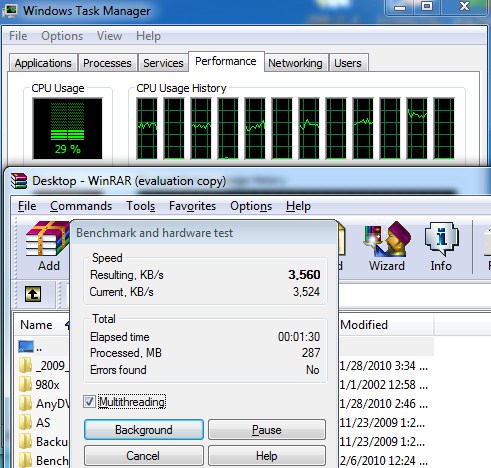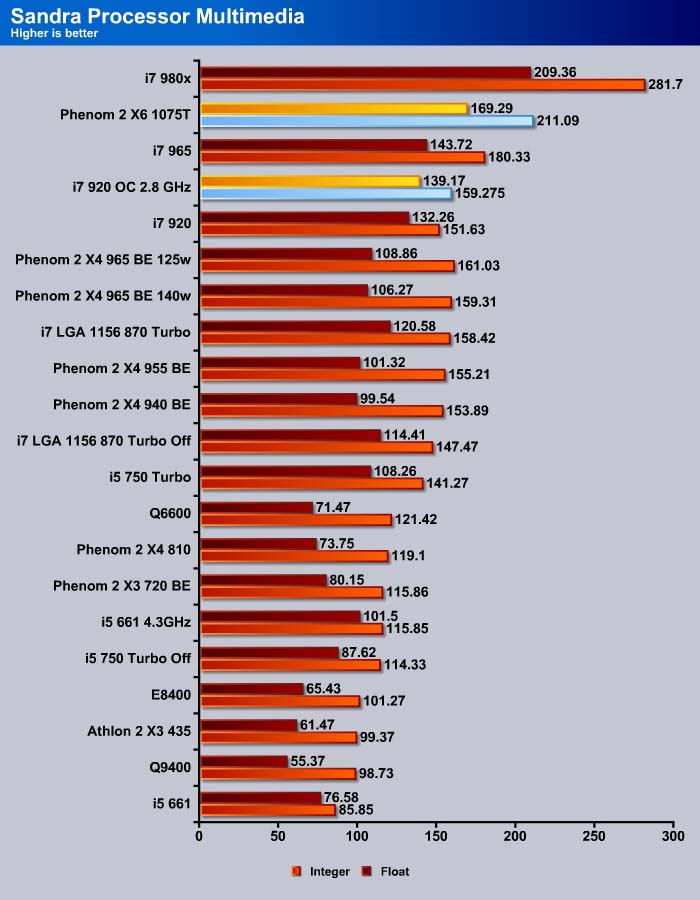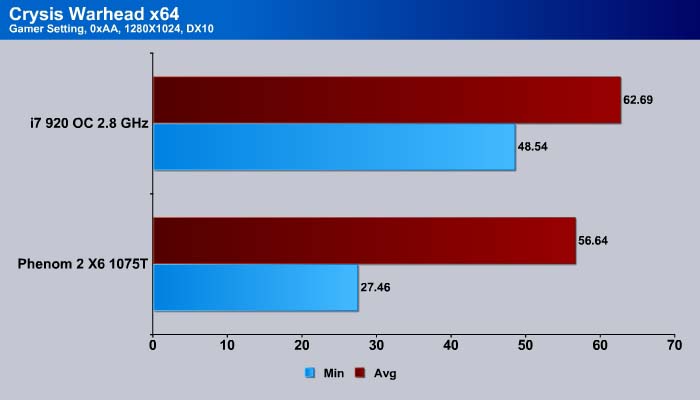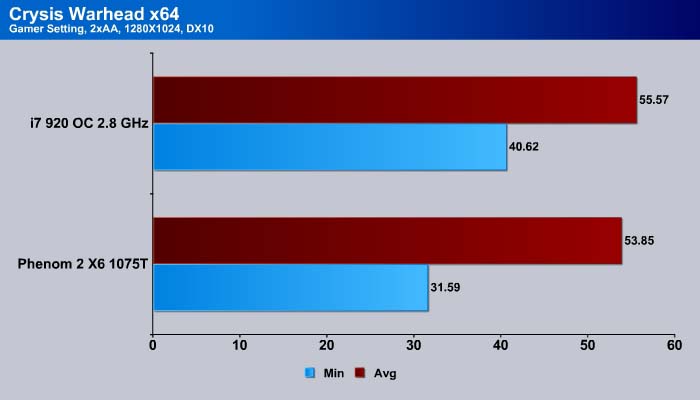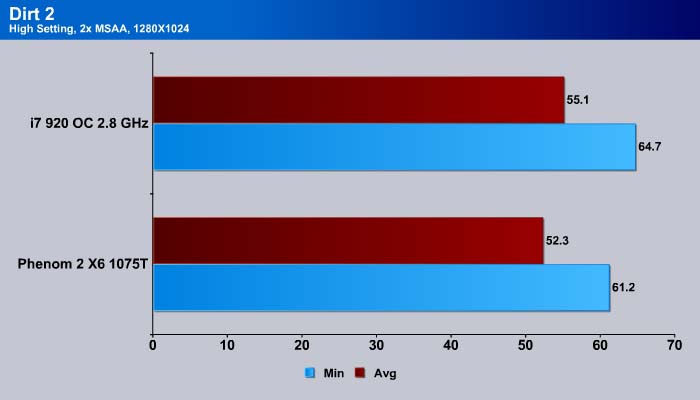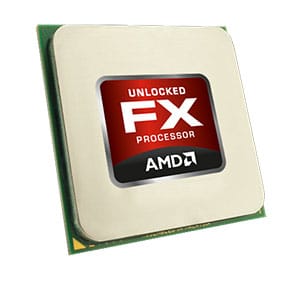AMD fills the gap of their six-core Phenom processor with the release of the X6 1075T at $245. A relatively cheap six-core processor that offers consumers who need the processing bandwidth and multi-tasking capability. Let’s find out how it stands against other processors.
Introduction
Intel has been following their “tick-tock” plan quite rigorously, which allows the company to keep Moore’s Law going. Unfortunately for consumers, Intel has made upgrades from one processor family to another a rather difficult task. While we cannot use newer processors in older generation motherboards due to differing socket layouts and power requirements, Intel makes it even more difficult to upgrade with their current generation of processors. Intel segments current processors into two different sockets: Socket LGA 1336 and Socket LGA 1156, neither of which are intercompatible. Even worse, the upcoming 32nm Sandy Bridge processors will not fit any current motherboards, instead introducing two brand new sockets. This continuous change of sockets forces customers to buy multiple boards and chips, putting unnecessary strain on wallets in this difficult economy.
AMD, on the other hand, is upgrading sockets with a gradual pace, and their current AM3 processors are backwards-compatible with older AM2+ motherboards. As a result, AMD offers attractive options for users wishing to upgrade to a new family of processors. AMD’s design allows consumers who have AM2+ based motherboards to perform incremental upgrades, eliminating the need to do an expensive and laborious overhaul of hardware. Customers can first upgrade to an AM3 processor on with their existing AM2+ board, then upgrade the motherboard (and memory) when funds are available.
Not only are AMD’s current processors compatible with older AM2/AM2+ motherboards, AMD also only has one type of socket for consumer processors. The Phenom II, Athlon II, Sempron, Opteron lines in six-core, quad-core, or dual-core type all fit into the same socket. This allows upgrade to a faster or to a greater number of cores processor without having to buy a new motherboard and memory.
AMD’s gradual socket replacement with backward compatibility sits well with the company’s current pricing strategy. Though Intel holds the title of the fastest processor, AMD is staying alive by competing against Intel with more cores. AMD often sells processor with three or four cores for the price an Intel dual-core. Not only that, AMD often prices their processor at a lower price than Intel, but offers the same performance. This strategy works fairly well for AMD, and their processors often excel in highly threaded applications, leaving Intel’s behind.
In April, AMD launched their six-core processors: the Phenom II X6 1090T and the Phenom II X6 1055T. The Phenom II X6 1090T is intended to compete against the Intel Core i7 950, currently selling at $290, while the Phenom II X6 1055T is intended to compete against the cheapest Core i7 920/930 (selling at $199). Today, the Phenom II X6 1075T (priced at $245) fills the gap between the two existing six-core processors.
AMD Phenom II X6 1075T
The architecture behind the Phenom II X6 1075T is based on the same Thuban core found on the Phenom II X6 1090T. While sharing the same basic architecture as the Phenom II X6 1090T, the Thuban has an improved Turbo Core technology that is similar to Intel’s Turbo Boost. When using applications that do not use all six-cores, the processor will shut down unused cores and throttle the remaining cores at a higher frequency within the TDP.
| Core Clock | Max Turbo | Cache (L2/L3) | TDP | Price | |
| Intel Core i7 980X | 3.33GHz | 3.60GHz | 1.5MB/12MB | 130W | $ 999.00 |
| Intel Core i7 970 | 3.2GHz | 3.42GHz | 1.5MB/12MB | 130W | $ 899.99 |
| AMD Phenom II X6 1090T | 3.2 GHz | 3.6 GHz | 3MB/6MB | 125W | $ 290.00 |
| AMD Phenom II X6 1075T | 3.0 GHz | 3.5 GHz | 3MB/6MB | 125W | $ 245.00 |
| AMD Phenom II X6 1055T | 2.8GHz | 3.3 GHz | 3MB/6MB | 125W | $ 199.99 |
| Intel Core i7 975 | 3.33GHz | 3.6GHz | 8MB | 130W | $ 562.00 |
| Intel Core i7 950 | 3.06 GHz | 3.33GHz | 8MB | 130W | $ 299.00 |
| Intel Core i7 930 | 2.8GHz | 3.06GHz | 8MB | 130W | $ 284.00 |
| AMD Phenom II X4 965 BE | 3.4GHz | N/A | 2MB/6MB | 125W/140W | $ 185.00 |
| Intel Core i7 870 | 2.93GHz | 3.6GHz | 8MB | 95W | $ 289.99 |
| Intel Core i5 750 | 2.66GHz | 3.2GHz | 8MB | 95W | $ 194.99 |
The Phenom II X6 1075T is clocked at 3.0GHz, 200 MHz lower than the Phenom II X6 1090T. It has a maximum Turbo Core clock speed of 3.5GHz. Like the rest of the Phenom II X6 processors, the 1075T also comes with 3MB L2 and 6MB L3 cache. Unfortunately, AMD kept the 1075T multiplier locked. We were disappointed with this fact, as we originally anticipated that the 1075T would have an unlocked multiplier. This means that any overclocking can only be done with increases in the FSB. The Phenom II X6 1075T has a maximum TDP of 130W, just like the other six-core processors.
Image of the Phenom II X6 die (source: AMD)
The 1075T is retailed at $245, $40 cheaper than the Core i7 930 and Core i7 870. It is also $35 more expensive than the Core i5 760. Let’s put this into perspective as we consider the whole system setup rather than just the CPU pricing.
| Component | Intel Core i7 | Intel Core i7 | Intel Core i5 | AMD Phenom X6 |
|---|---|---|---|---|
| Processor | Core i7 930 $250 | Core i7 860 $283 | Core i5 750 194.99 | Phenom 2 X6 1075T $245 |
| Memory | Kinston HyperX 3x2GB DDR3 1600 $142.99 | Kinston HyperX 2x2GB DDR3 1600 $99.99 | Kinston HyperX 2x2GB DDR3 1600 $99.99 | Kinston HyperX 2x2GB DDR3 1600 $99.99 |
| Motherboard | $150~$250 | $80~$200 | $80~$200 | $100~$200 |
| Total | $542.99~$642.99 | $462.99~$582.99 | $374.98~$494.98 | $444.99~$544.99 |
We can see that the Phenom X6 1070T system is priced between the Intel Core i5 setup and Core i7 setup. It runs about $50 higher than the Core i5 750 and $30 cheaper than the Core i7 860 when paired with the cheapest motherboard. Because Socket 1366 motherboards are more expensive and require triple channel memory, they cost an extra $100.
Testing & Methodology
Since AMD priced the X6 1075T between the Core i7 and Core i5, we have decided to do a direct comparison between the two system setups. We tried to make both systems as similar as we could including hard drive, memory, graphic cards, so only variables would be the processor and motherboard. We overclocked the Core i7 920 to 2.8GHz to mimic the speed of the Core i7 930 currently available on the market ($284 MSRP). In addition, we also threw in the scores of a few other processors we have tested previously, in order to see how the 10975T compares against other processors.
Intel system:
- Core i7 920 OC to 2.8GHz
- Cooler Master V6
- Gigabyte EX58-UD4P
- 6 GB Kingston DDR3 @ 1600 MHz
- Seagate 7200.12
- Gigabyte HD5770 Super Overclocked
- Cooler Master UCP 900W
AMD Phenom II X6 system:
- AMD Phenom X6 1075T
- Thermalright SI-128
- 4 GB Kingston DDR3 @ 1600 MHz
- Gigabyte 785GMT
- Seagate 7200.12
- Gigabyte HD5770 Super Overclocked
- Cooler Master UCP 900W
Other Intel system:
- Skythe Ninja Rev B cooling
- Intel X58 (DX58SO)
- 6 GB Corsair DDR3 @ 1333 MHz
- Apacer 64 GB SSD for OS
- SATA6 drive specs
- Kingston 64 GB V+ SSD in Icy Dock USB3-enclosure
- XFX HD5870 Eyefinity Edition 2 GB video card
- Cougar 550W PSU
AMD Phenom system:
- Noctua NH-C12 cooler
- 4 GB OCZ Black Edition DDR3 @ 1033 MHz
- ASUS M4A78T-E
- Apacer 64 GB SSD for OS
- SATA6 drive specs
- Kingston 64 GB V+ SSD in Icy Dock USB3-enclosure
- XFX HD5870 Eyefinity Edition 2 GB video card
- Cougar 550W PSU
The OS for all systems were Windows 7 Professional 64-bit. We used Acronis True Image 11 to set up each system with a fresh install of Windows 7.
In addition to all the drivers, we also installed AMD OverDrive on the AMD systems.
OVERCLOCKING
We’ll begin with the most interesting topic—overclocking. The 1075T has the multiplier locked so to overclock it, we had to raise the FSB. Overclocking the Phenom 2 six core processors is slightly different than previous generation of processors because there are two speeds that can be overclocked. The first is the frequency that all six cores would run at, and the second is the frequency that three or fewer cores run at with Turbo Core enabled.
The latest AMD Overdrive software allows for the option to turn the Turbo Core feature on and off. In addition, it allows users to fine-tune how Turbo Core will function, and overclock the processor. The software is fairly easy to use. It also comes with a slew of other neat tools to monitor computer hardware information and control different hardware components. Of course, with most overclocking, we prefer to use the motherboard’s BIOS setting, so we opted to use the BIOS on our Gigabyte 785G motherboard to overclock the processor.
We decided to disable the Turbo Core and see how far we could push the processor’s six-cores. At default voltage, we got the processor to 3450MHz with 230MHz FSB and lower the NB frequency to x9 and the memory to x4. After raising the CPU voltage to 1.375V, I was able to squeeze 400MHz out of the CPU to get a 3.8 GHz. This is achieved with 255 FSB, x8 NB, and x4 memory.
At 3.8 GHz, the processor is able to run Prime95 with all six cores at a stable maximum load temperature of 56°C. We believe that with a bit more time and tweaks, we may be able to reach to 4GHz. Still, going from 3.0 GHz to 3.8 GHz is not a bad deal considering the fact that the multiplier is locked.
When we enabled the Turbo Core, we were forced to lower clock speed to 3.6 GHz with 4.2 GHz Turbo Core in order to boot into Windows. We tested to see if Turbo Core was working properly by running Prime95 single core, and saw the CPU clock speed throttled between 3.6GHz and 4.2 with CPU-Z. However, the system crashed when three cores were running the Prime95 test. Because AMD did not implement a power gate to completely shut down the unused cores, this hindered the processor’s ability to stay within the TDP when the processors were running three cores at 4.2 GHz.
Everest Ultimate v.5.50
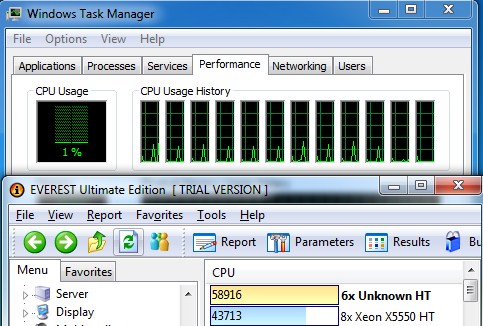
“EVEREST Ultimate Edition is an industry leading system diagnostics and benchmarking solution for enthusiasts PC users, based on the award-winning EVEREST Technology. During system optimizations and tweaking it provides essential system and overclock information, advanced hardware monitoring and diagnostics capabilities to check the effects of the applied settings. CPU, FPU and memory benchmarks are available to measure the actual system performance and compare it to previous states or other systems. Furthermore, complete software, operating system and security information makes EVEREST Ultimate Edition a comprehensive system diagnostics tool that offers a total of 100 pages of information about your PC.”
CPU AES
This integer benchmark measures CPU performance using AES (a.k.a. Rijndael) data encryption. It utilizes Vincent Rijmen, Antoon Bosselaers’, and Paulo Barreto’s public domain C code in ECB mode.
CPU AES test uses only the basic x86 instructions, the test consumes 48 MB memory, and it is Hyper Threading, multi-processor (SMP) and multi-core (CMP) aware.

As expected, the Phenom 2 X6 1075T comes in just a tad under the Phenom 2 X6 1090T in the Everest AES test. Everest AES scales the processor speed and the number of cores very well, and we can see that the X6 1075T places just above the fastest quad-core i7, the i7 965.
CPU PhotoWorxx
This integer benchmark performs different common tasks used during digital photo processing.
It performs the following tasks on a very large RGB image:
• Fill
• Flip
• Rotate90R (rotate 90 degrees CW)
• Rotate90L (rotate 90 degrees CCW)
• Random (fill the image with random colored pixels)
• RGB2BW (color to black & white conversion)
• Difference
• Crop
This benchmark stresses the integer arithmetic and multiplication execution units of the CPU and also the memory subsystem.
CPU PhotoWorxx test uses only the basic x86 instructions, and it is Hyper Threading, multi-processor (SMP) and multi-core (CMP) aware.
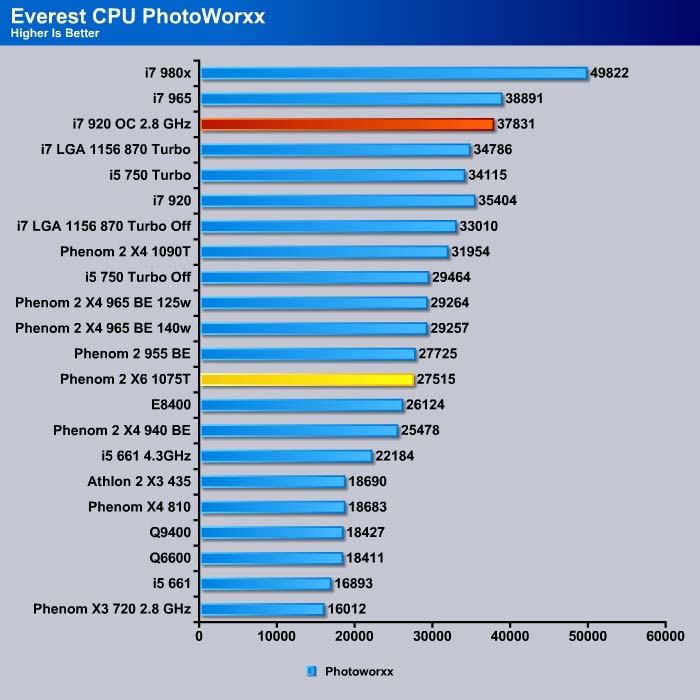
The PhotoWorxx tests both the CPU and the memory subsystem so it gives a slightly more realistic result. Here, the X6 1075T and the X6 1090T trail a bit behind Core i7 quad cores. However, the result of the 1075T is a bit off and we think it could be the 785G chipset that was used to test the CPU.
CPU Queen
This simple integer benchmark focuses on the branch prediction capabilities and the misprediction penalties of the CPU. It finds the solutions for the classic “Queens problem” on a 10 by 10 sized chessboard.
CPU Queen test uses integer MMX, SSE2 and SSSE3 optimizations. It consumes less than 1 MB system memory and it is Hyper Threading, multi-processor (SMP) and multi-core (CMP) aware.
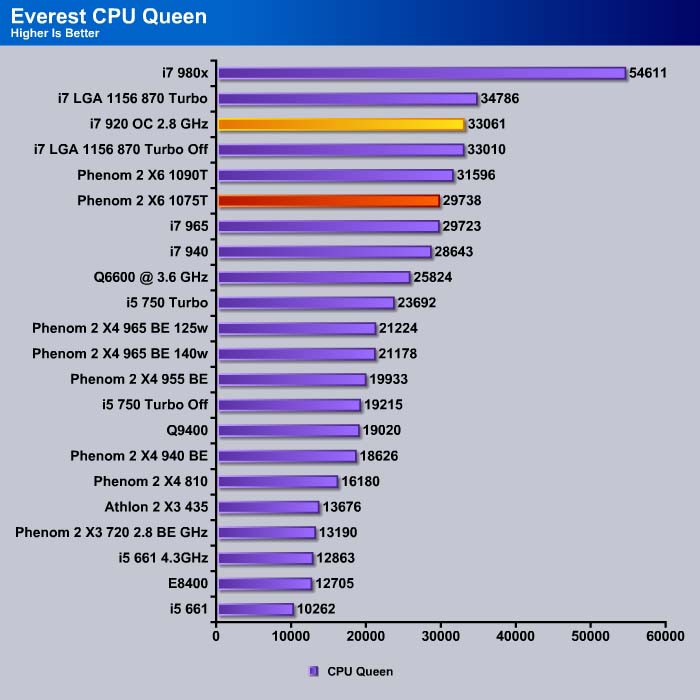
The CPU Queen test again shows us the advantage of six cores, so the 1075T scores fairly well here, coming in just under the 1090T. The overclocked 920 actually puts out a higher score than the 1075T. We believe this is due to fact we had to raise the FSB in order to achieve 2.8GHz so the extra frequency helped with the performance. We can see that the 1075T outperforms the Core i5 750 and i7 940 running at stock speed.
CPU Zlib
This integer benchmark measures combined CPU and memory subsystem performance through the public ZLib compression library Version 1.2.3 (http://www.zlib.net).
CPU ZLib test uses only the basic x86 instructions, and it is Hyper Threading, multi-processor (SMP) and multi-core (CMP) aware.
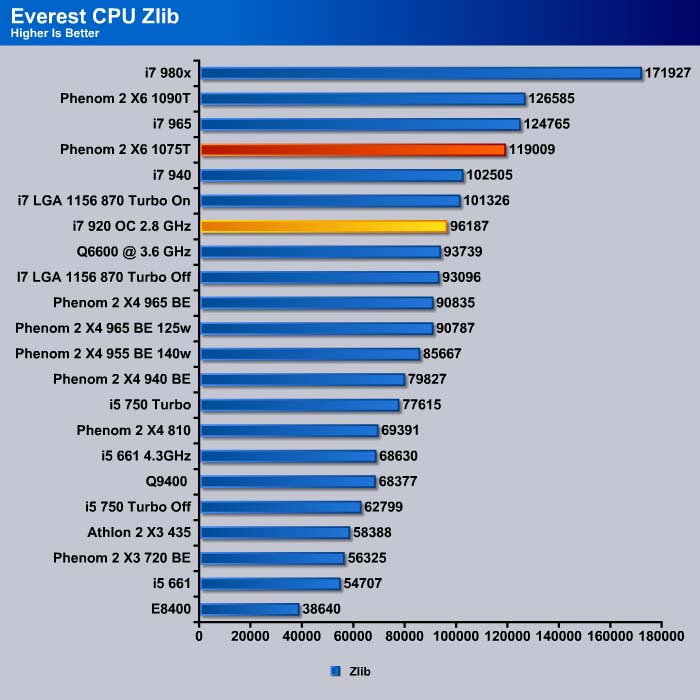
ZLib is heavily threaded, and this is where we can really see the benefit of the six-core processor. Here, the top spots are taken by six-cores (with the exception of the fastest quad-core i7 965).
Everest Memory
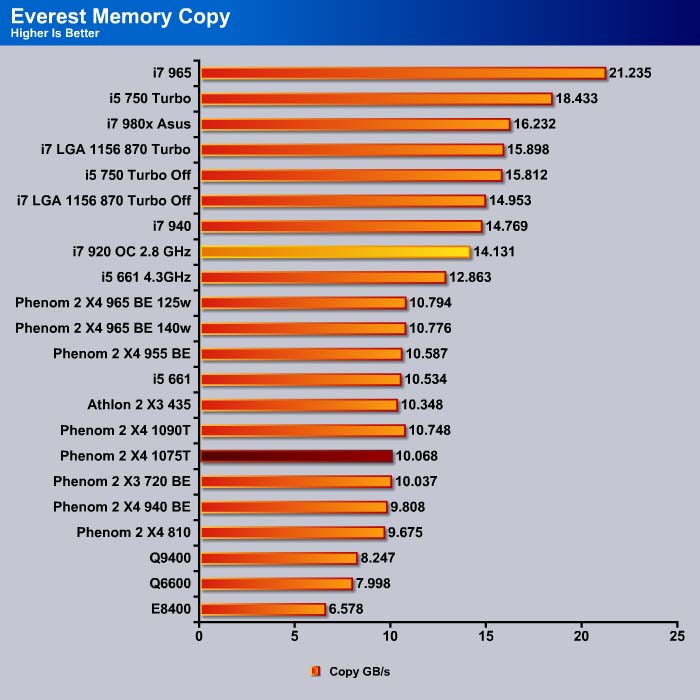
All Core i7 900 are triple channeled so they show a better performance than the dual-channel Phenom processors. The dual channel Socket 1156 Core i5/i7 also shows a good result here, with approximately 14GB/s memory copy bandwidth.
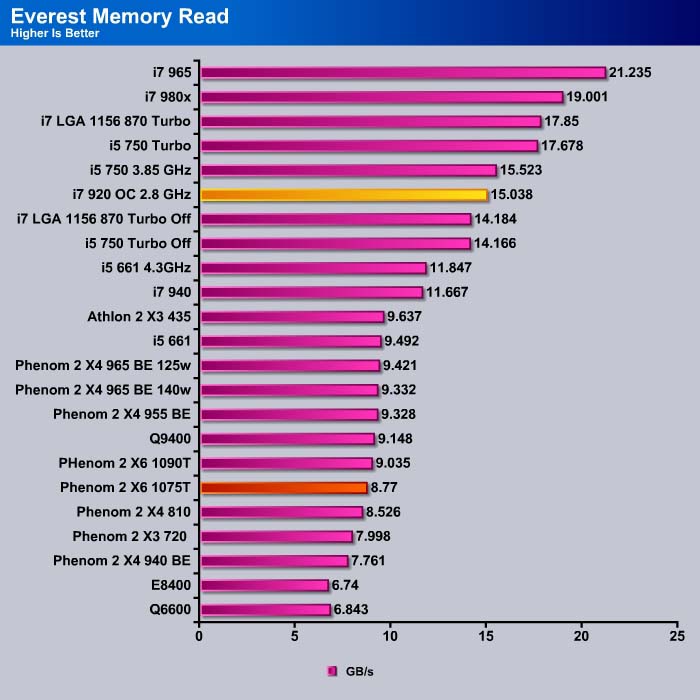
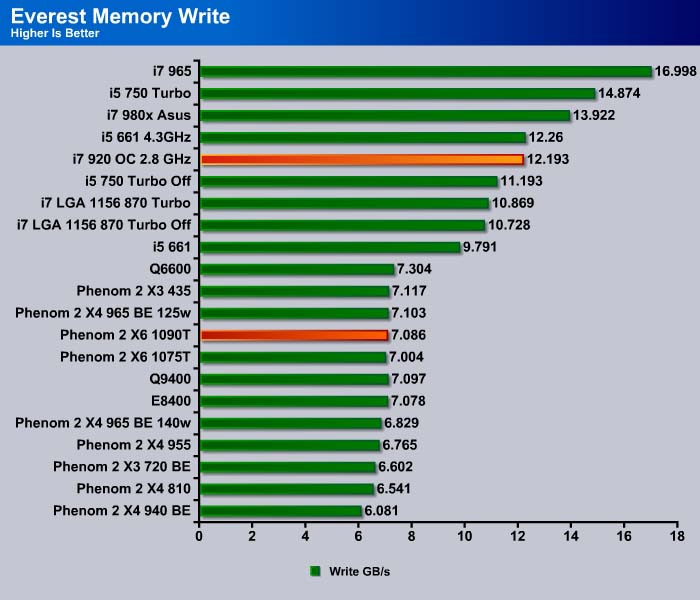
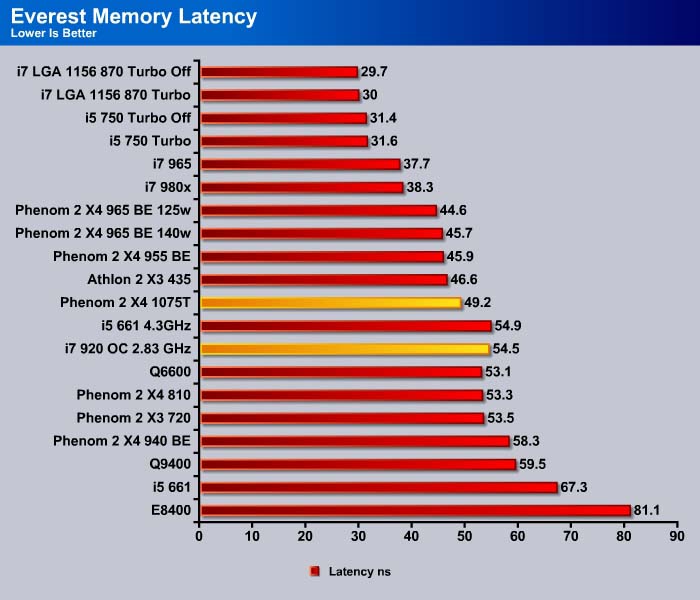
The Phenom processor actually has a better latency than the overclocked Core i7 920. We used the same sticks of memory for both the 1075T and the overclocked i7 920, and as we can see, the X6 1075T actually has a lower latency.
WinRar 3.8
Notice WinRar is driving 6 cores and the hyperthreaded cores aren’t used. This is one reason why we use a wide variety of benchmarks: we want to see performance across a wide range of conditions.
This module in WinRar generates random data, which contains specially introduced redundancy, increasing the load to both the processor and memory. Data is then passed through RAR compression and decompression algorithms, and the output of the decompression algorithm is compared to the source data. If any differences are found, WinRar then reports “Errors found – Yes” in the command window. WinRar displays a size of processed data and compression speed, current and resulting, in kilobytes per second.
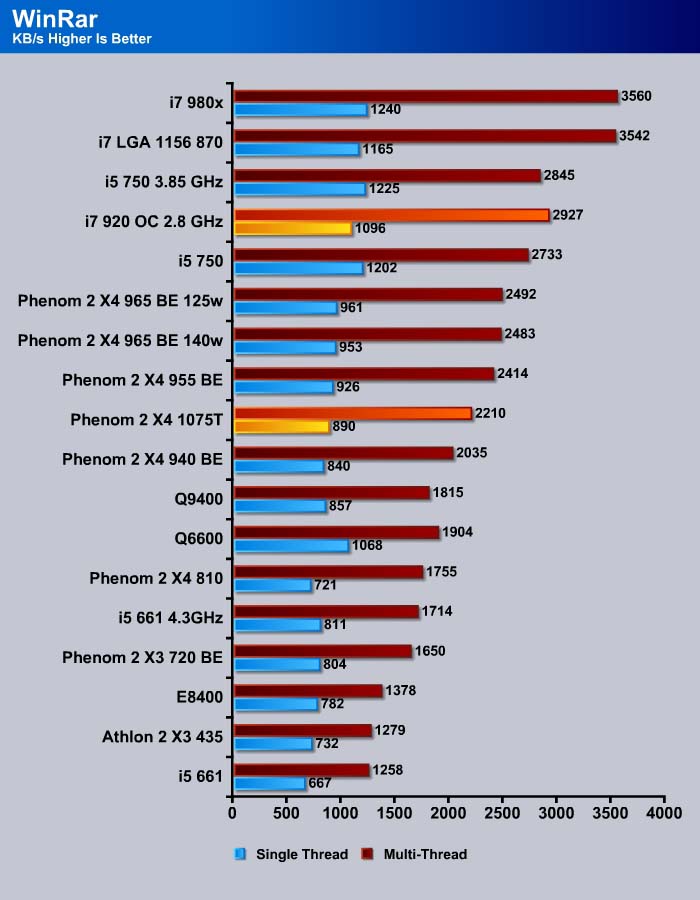
WinRar gives best results with a faster CPU and memory subsystem so we do not expect it to stress all of the Phenom 2 X6 1075T’s six cores.

We ran the WinRar workload test, in which we compress several large image files and record the time. As expected, the higher memory performance of the i7 shows a clear dominance over the Phenom processors. While the X6 1075T can throttle to 3.5 GHz with the Turbo Core, it comes in just a tad behind the 3.4GHz Phenom X4 965. WinRAR is one of the few instances where Turbo Core does not always show a performance gain.
Sisoft Sandra 2010
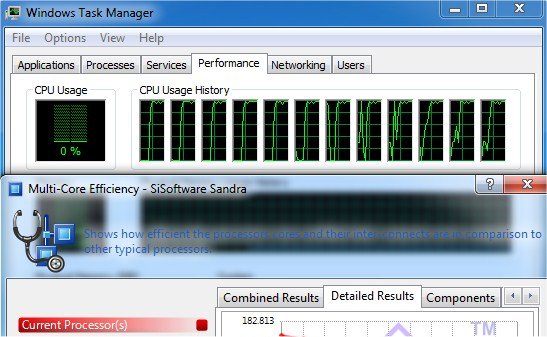
“SiSoftware Sandra (the System Analyzer, Diagnostic and Reporting Assistant) is an information & diagnostic utility. It should provide most of the information (including undocumented) you need to know about your hardware, software and other devices whether hardware or software. It works along the lines of other Windows utilities, however it tries to go beyond them and show you more of what’s really going on. Giving the user the ability to draw comparisons at both a high and low-level. You can get information about the CPU, chipset, video adapter, ports, printers, sound card, memory, network, Windows internals, AGP, PCI, PCI-X, PCIe (PCI Express), database, USB, USB2, 1394/Firewire, etc.”
The Sandra Processor Multi-Media result for the X6 1075T was rather impressive. The X6 1075T comes in 26 points higher in Integer calculation and 30 points higher in float point calculation than the Core i7 965. Compared to the Core i7 920, the processor scored 46 points higher in Integer and 60 points higher in float point.
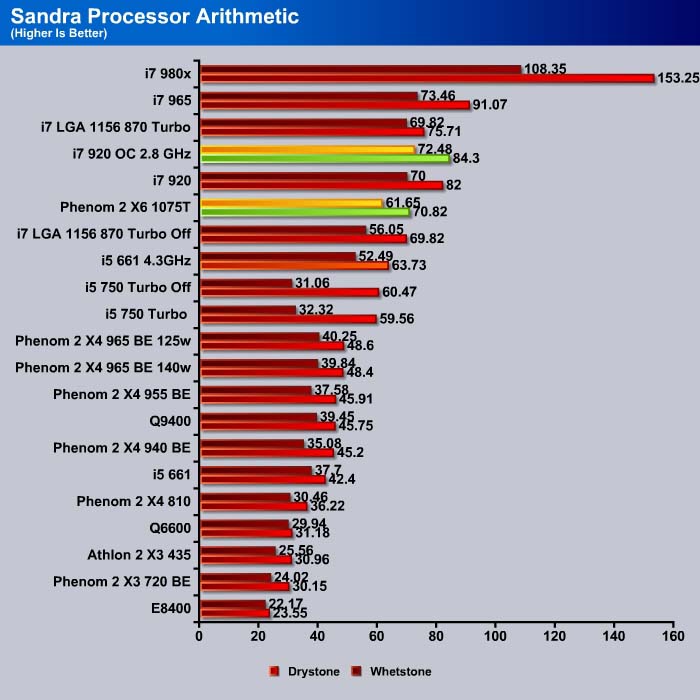
The Processor Arithmetic test shows the X6 1075T comes in just a tad under the Core i7 920, with 61.65 points in Dhrystone and 70.82 points in Whetstone.
Pov-Ray 3.7 Beta
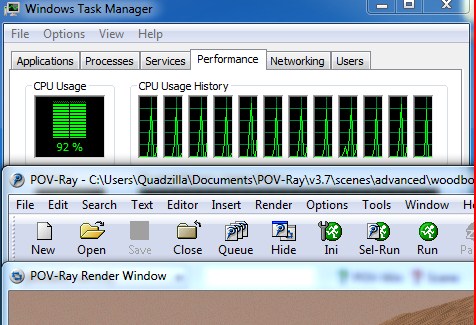
The Persistence of Vision Ray-Tracer was developed from DKBTrace 2.12 (written by David K. Buck and Aaron A. Collins) by a bunch of people (called the POV-Team) in their spare time. It is a high-quality, totally free tool for creating stunning three-dimensional graphics. It is available in official versions for Windows, Mac OS/Mac OS X and i86 Linux. The POV-Ray package includes detailed instructions on using the ray-tracer and creating scenes. Many stunning scenes are included with POV-Ray so you can start creating images immediately when you get the package. These scenes can be modified so you do not have to start from scratch. In addition to the pre-defined scenes, a large library of pre-defined shapes and materials is provided. You can include these shapes and materials in your own scenes by just including the library file name at the top of your scene file, and by using the shape or material name in your scene. Since this is free software feel free to download this version and try it out on your own.
Tthe biggest difference between POV-Ray 3.6 and 3.7 Beta 25 is SMP (symmetric multiprocessing) support, which means that POV-Ray can take advantage of as many cores as the CPU has. On Single vs Dual CPU systems, the speed almost doubles.
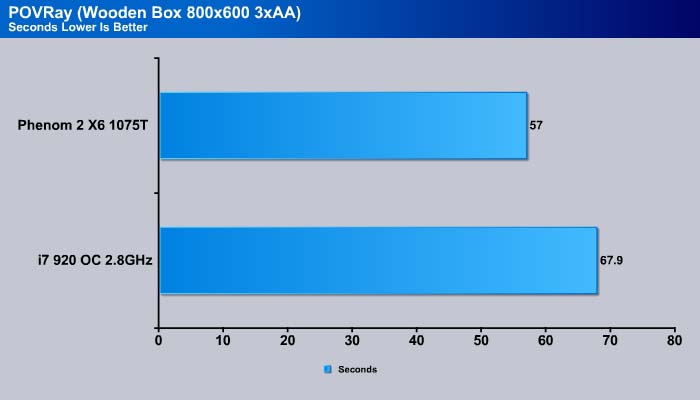
POV-Ray takes the advantage of the extra cores, so we can see here that the Phenom X6 1075T is able to finish the job 10 seconds faster than our overclocked i7 920.
Excel
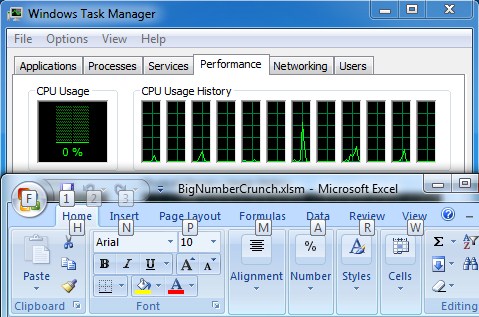
Microsoft Excel is the widely known and most used spreadsheet application for the manipulation and calculation for number crunching. With Excel you can analyze and share information on small scale or the largest scale you can imagine. We’ve seen spreadsheets in every day use that contain literally tens of thousands of numbers and hundreds of equations. Bjorn3D uses two tests in Excel to determine CPU and Motherboard performance.
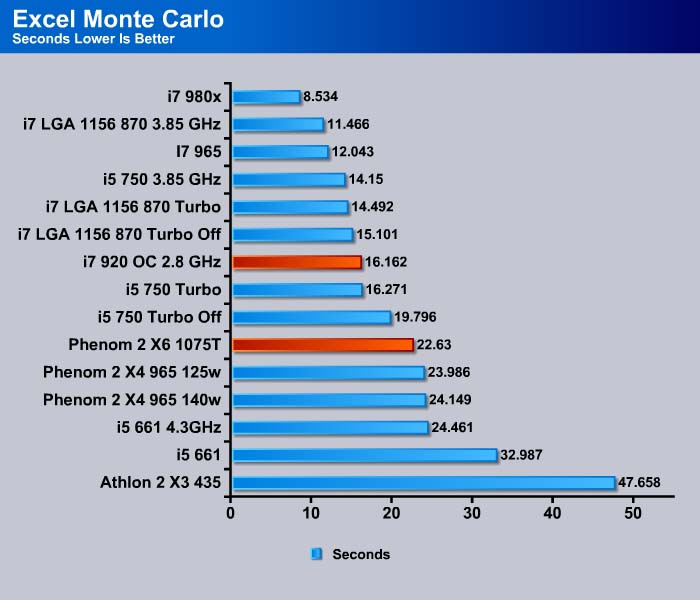
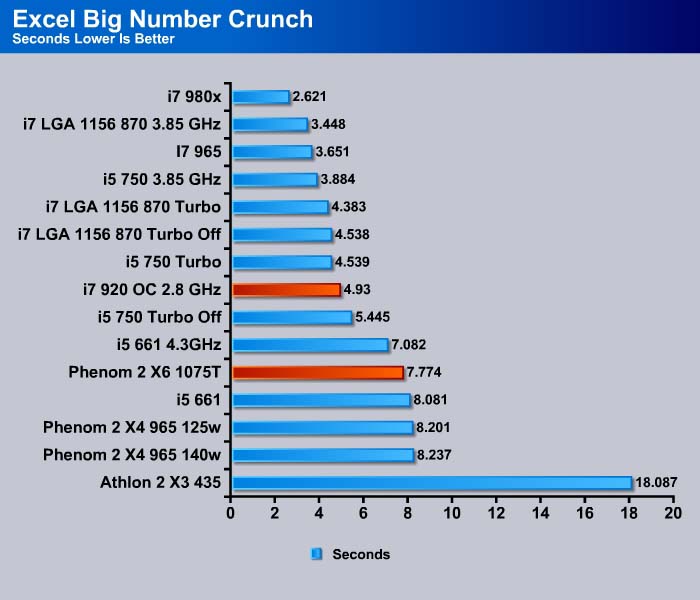
The Excel tests shows the X6 1075T is faster than any of the Phenom X4 quad cores, most likely due to the extra 100MHz that the Turbo Core provides. Excel 2007 does support multithread, but it still does not push the processor as hard as we would have hoped. Since Excel often take the advantage of the memory bandwidth, the Core i7 triple channel memory shows its benefit over the dual-channeled Phenom processors.
AutoMKV 0.95c
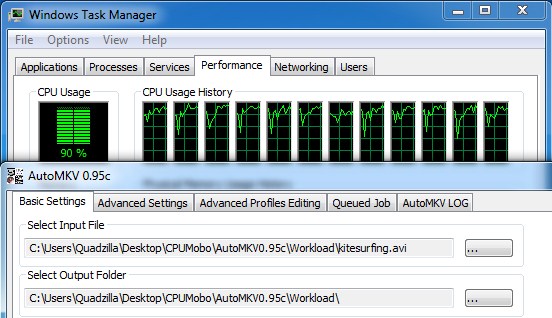
AutoMKV is an application aiming for easy media conversion between various media formats using various third party codecs. With improved internet speed and enhanced computing power, more users are interested in encoding to different media formats for their various multimedia needs. With AutoMKV and x264 codec, a freeware H.264 encoder, users can easily create media files. For more information and to obtain AutoMKV 0.95c and AviSynth* 2.5.7, please visit (http://forum.doom9.org/showthread.php?t=134478). We create a media file using AutoMKV and x264 codec. The input file used in the document is a raw 416 MB 720×480 DV file and the output is a 253MB H.264 media file.
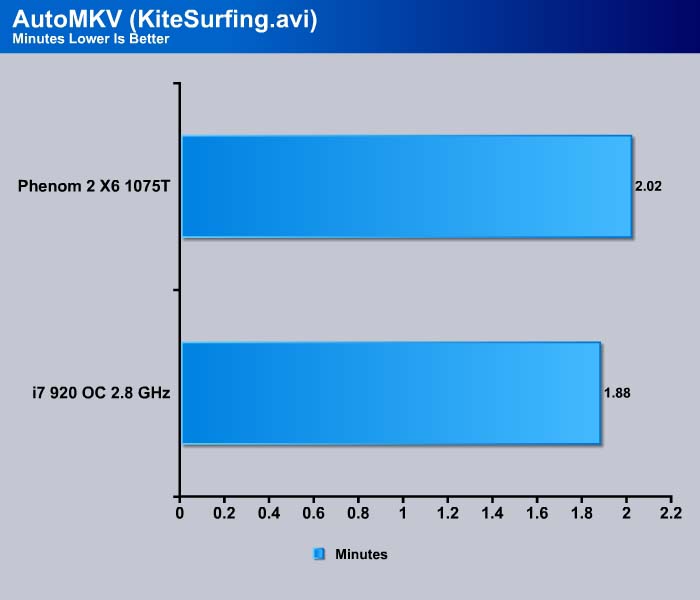
In AutoMKV, the 1075T gave us a result of 2.02 minutes while the overclocked i7 920 gave us 1.88 minutes.
Blender

Blender is a free open source 3D content creation suite that is available for various operating systems. The application is popular among many independent animation studios and game makers. For more information, please visit http://www.blender.org/.
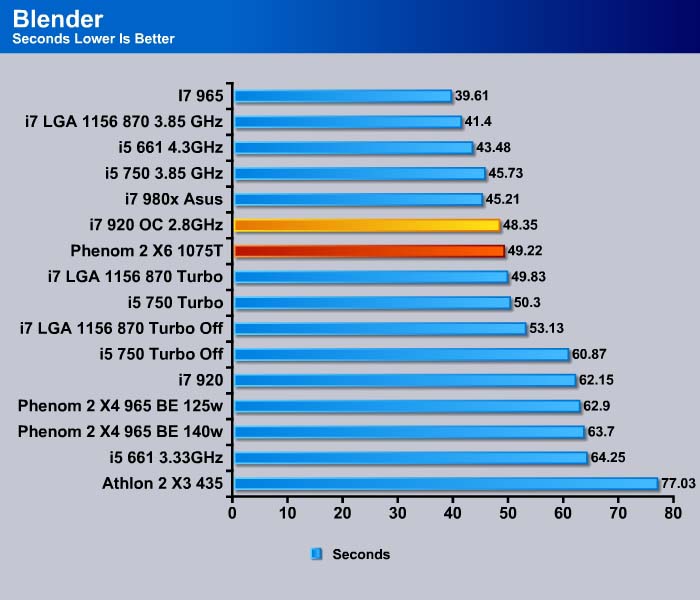
Blender does not particularly show the benefit of multiple cores. In fact, we can see the raw processor speed is the determining factor here. The X6 1075T finishes the task 13 seconds faster than the Phenom 2 X4 965 due to the extra 100MHz. AMD latest Turbo Core clearly shows its benefit with applications that cannot take advantage of the extra cores. The Phenom X2 1075T is just a tad slower than our overclocked 920 but faster than any of the Socket 1156 quad core processors.
Cinebench R11.5
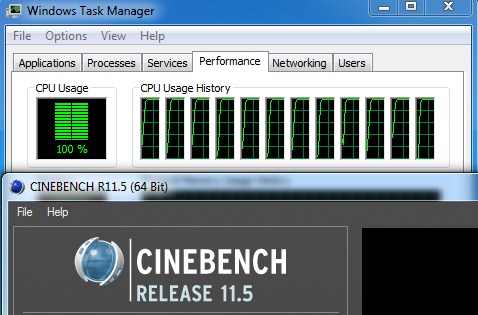
“CINEBENCH is a real-world test suite that assesses your computer’s performance capabilities. MAXON CINEBENCH is based on MAXON’s award-winning animation software, CINEMA 4D, which is used extensively by studios and production houses worldwide for 3D content creation. MAXON software has been used in blockbuster movies such as Spider-Man, Star Wars, The Chronicles of Narnia and many more. MAXON CINEBENCH runs several tests on your computer to measure the performance of the main processor and the graphics card under real world circumstances. The benchmark application makes use of up to 16 CPUs or CPU cores and is available for Windows (32-bit and 64-Bit) and Macintosh (PPC and Intel-based). The resulting values among different operating systems are 100% comparable and therefore very useful with regard to purchasing decision-making. It can also be used as a marketing tool for hardware vendors or simply to compare hardware among colleagues or friends.”
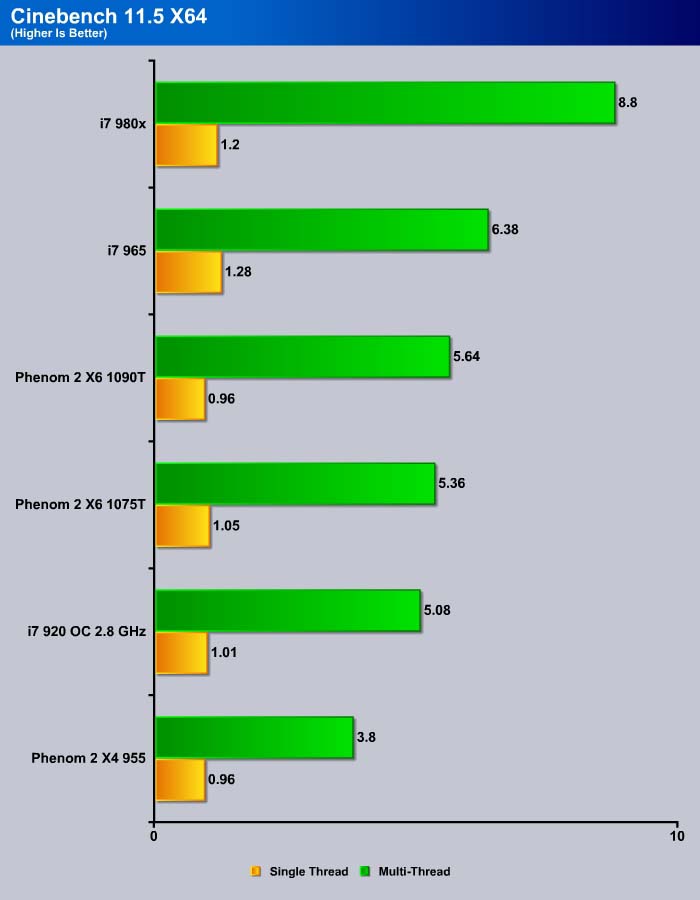
The latest Cinebench 11.5 64-Bit shows that the X6 1075T comes just a tad under the 1090T, but ahead of the overclocked i7 920. The 1075T surprised us by scoring 0.09 points higher than the 1090T in the single thread, and 0.04 points higher than the 920. The processor also scored 0.30 points higher in the multi-threaded test. This is one test that clearly shows the benefit of the six-core Phenom.
Cinebench R10 64 Bit


The Cinebench CPU Ratio test shows that the i7 920 has a core efficiency of 4.08 cores while the Phenom X6 1075T has a core efficiency of 4.35 cores, and the i7 980x has an efficiency of 5.41 cores.
ProShow Gold 4.1
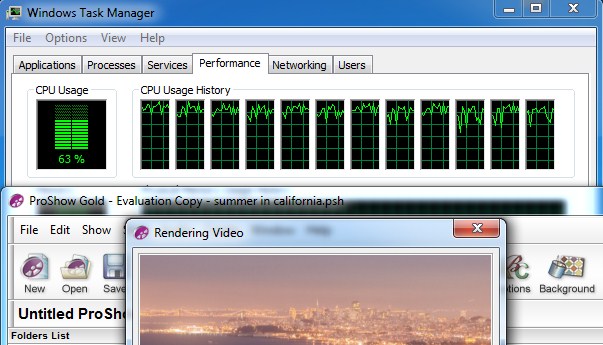
ProShow Gold allows you to combine videos and photos and music to create slide shows, depending on the end user results can be spectacular. The application allows the end user to share photos and memories with friends in a unique and spectacular way, the different formats supported are, DVD, PC and Web. Still Photos are brought to life by adding motion effects. Supported effects include, Pan, Zoom, and rotate. You can also add captions and over 280 transition effects.
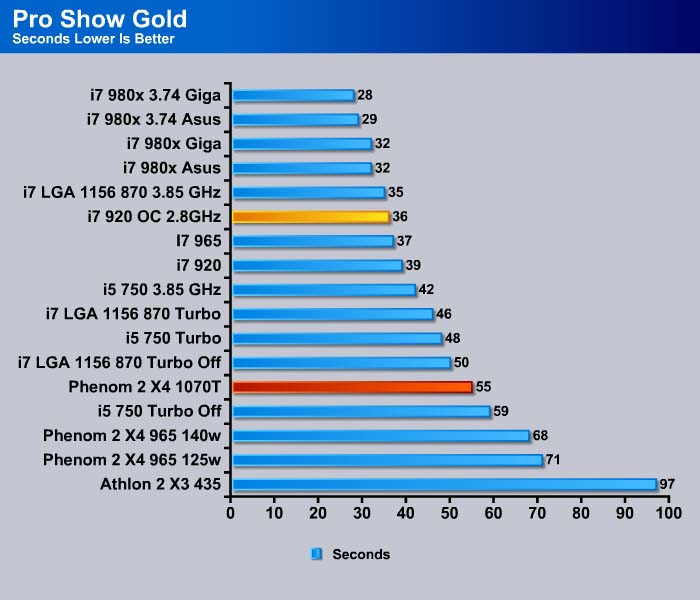
In ProShow Gold, we encode the video to the DVD format and the result shows the 1075T ha a significant gain over the X4 965, finishes the job in 13 seconds fewer than the X4 965. However, X6 1075T lags 5 seconds behind the Intel Core i7 870 but comes in 4 seconds ahead of the i5 750.
We decided to run a direct comparison between the overclocked i7 920 and the X6 1075T to see the performance differences when encoding to HD quality. Here we can see the our overclocked i7 920 finishes the job 1.37 minutes faster than the X6 1075T when doing HD encoding.
3DMark Vantage
For complete information on 3DMark Vantage Please follow this Link:
www.futuremark.com/benchmarks/3dmarkvantage/features/
The newest video benchmark from the gang at Futuremark. This utility is still a synthetic benchmark, but one that more closely reflects real world gaming performance. While it is not a perfect replacement for actual game benchmarks, it has its uses. We tested our cards at the ‘Performance’ setting.
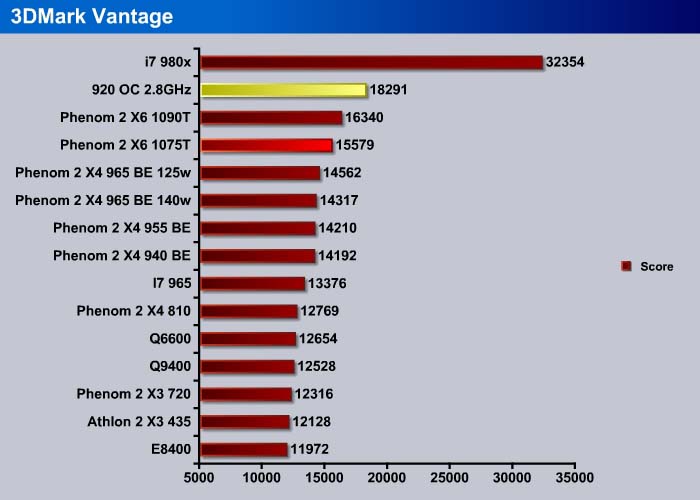
The Phenom X2 1075T scored 15579 in the Vantage CPU benchmark, just a tad under the X6 1090T. Our overclocked 920 actually yielded a higher score of 18291.
Crysis warhead
Crysis Warhead is the much anticipated standalone expansion to Crysis, featuring an updated CryENGINE™ 2 with better optimization. It was one of the most anticipated titles of 2008.
We ran Warhead using gamer’s setting at resolution of 1280×1024 and DirectX 10. We tested both no AA an 2x AA.
The Intel Core i7 920 overclocked to 2.8 offers 10% gain over the X6 1075T in the average frame rate without any AA turned on.
When we enable the AA, we see the Core i7 920 OCed shows only 3% gain over the X6 1075T.
Dirt 2
Dirt 2 is the squeal to the popular racing game Colin McRae Dirt. This is a standard racing game, but with an off road twist. Instead of racing Bugattis and Porsches, players race trophy trucks and rally cars.
Again, we put the Core i7 920 OC to 2.8GHz against the X6 1075T and test them with Dirt 2. In this game, we use high setting at 1280×1024 with no AA and 2xAA.
Without any AA, the i7 920 OCed shows 16% minimum frame rates and 6% average frame rate gain over the X1075T.
Clearly, gaming is always more GPU bound than CPU bound, and we can clearly see that pairing the X6 1075T with a good video card should give good gaming performance. The performance difference between the two CPUs could be anywhere between 3-6%. The money saved on the slightly cheaper X6 1075T can be put toward a more powerful graphic card.
POWER CONSUMPTION
We ran Prime95 to stress the CPU in order to measure the overall system power consumption. All of the power saving features (C&Q and SpeedStep) have been enabled, as we envision this is how most people will be running their system.
Looking at the overall system power consumption, we can see that the Phenom II X6 1075T offers impressive power consumption over Intel Core i7. Here we can see that the AMD system consumes 40W fewer idle and 51W fewer under load.
CONCLUSION
Today’s launch of the X6 1075T fills the gaps between the X6 1090T and X6 1055T. As expected, the six-core processor shines in applications that are heavily threaded. Unfortunately, not many desktop applications, such as games and Office Suites, are heavily threaded enough to really take the advantage of the extra cores. Many applications still only utilize two (at most four) cores effectively. This is where the addition of Turbo Core comes in to offer a boost in performance for those applications that cannot take the advantage of the extra cores.
We actually hoped the 1075T would come with an unlocked multiplier for easier overclocking, but our guess is that AMD wants to reserve that for the top of the line 1090T. Luckily, the processor overclocked to 3.8 GHz without many adjustments, and it can reach to higher speeds for users who are willing to invest the time and equipment.
In our benchmarks, we can see that the X6 1075T often comes in ahead of the i5 750, and traded places between the i7 870 and i7 920 depending on whether the tests considered utilized the extra cores. The performance fits well with how AMD priced the processor. If we take the system built into consideration, we can see that the Phenom X6 1075T offers a good price-to-performance ratio. The overall system setup for the AMD system would be less expensive due to a lower cost motherboard than Socket 1366. This saved money can be put toward a faster video card or a better memory kit for overclocking.
The X6 1075T is definitely not a bad choice for anyone looking to upgrade their existing Socket 775 setup or AMD system to take the advantage of extra cores. It also offers a good performance-to-price ratio, and its extra cores will prove useful once the software catches up with the hardware. Core i7 users will probably not want to switch over, unless the applications that they are using can really utilize the extra cores.
| OUR VERDICT: AMD PHENOM II X6 1075T | ||||||||||||||||||
|
||||||||||||||||||
| Summary: The AMD Phenom II X6 1075T offers an excellent performance-to-price ratio, and with a combination of six-core and Turbo Core, it has a good balance of performance for both light and heavy threaded applications. We are proud to give it the Bjorn3D Silver Bear Award. |
 Bjorn3D.com Bjorn3d.com – Satisfying Your Daily Tech Cravings Since 1996
Bjorn3D.com Bjorn3d.com – Satisfying Your Daily Tech Cravings Since 1996
